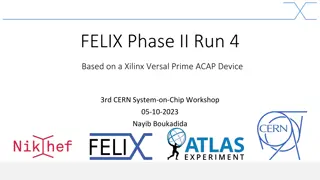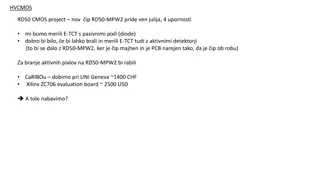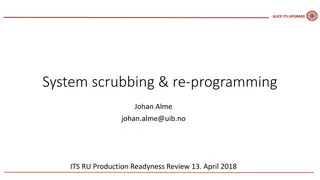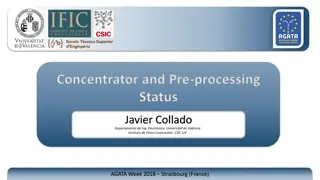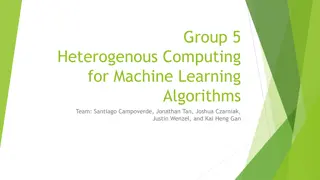Understanding FELIX Phase II Run 4 and Versal Prime ACAP Device
Explore the advancements in FELIX Phase II Run 4, leveraging Xilinx Versal Prime ACAP Device, showcased at the 3rd CERN System-on-Chip Workshop. Witness massive improvements in trigger rates, data readout rates, and interactions per bunch crossing. Dive into the hardware details and Versal Prime's c
2 views • 36 slides
FPGA Accelerator Design Principles and Performance Snapshot
This content explores the principles behind FPGA accelerator design, highlighting the extreme pipelining via systolic arrays that enables FPGAs to achieve high speeds despite lower clock frequencies compared to CPUs and GPUs. It delves into the application of Flynn's Taxonomy, performance snapshots
0 views • 17 slides
Advanced Technologies for Particle Detection and Monitoring
Cutting-edge technology such as HVCMOS RD50-CMOS project along with CaRIBOu and Xilinx ZC706 evaluation board are being employed for precise measurements in E-TCT with passive and active pixel detectors. The development of Radiation Monitor Sensor Boards for ITk, involving sensors like RadFETs and d
0 views • 6 slides
Overview of ALICE ITS UPGRADE System Scrubbing and FPGA Programming
ALICE ITS UPGRADE system undergoes scrubbing for error correction using various techniques like Xilinx Soft Error Mitigation Core and External Scrubbing Network. The FPGA programming overview includes standard operations, remote updating methods, and FPGA versions timeline. Relevant topics cover dat
0 views • 19 slides
Concentrator and Pre-Processing Status in IDM Hardware
Throughout the IDM Hardware components detailed in the provided content, there is a focus on the concentrator and pre-processing status involving various modules essential for system functionality, such as control, memory, sensors, and power. The testing and validation processes are also highlighted
0 views • 9 slides
Enhancing Machine Learning Algorithms with Heterogeneous Computing
Team 5 is working on expanding a prior initiative by developing code to simultaneously run three different machine learning algorithms - Preprocessing, Blink Detection, and Eye Tracking. Their project involves implementing these algorithms on a Xilinx Kria evaluation board using process and memory i
0 views • 6 slides
Efficient Video Encoder on CPU+FPGA Platform
Explore the integration of CPU and FPGA for a highly efficient and flexible video encoder. Learn about the motivation, industry trends, discussions, Xilinx Zynq architecture, design process, H.264 baseline profile, and more to achieve high throughput, low power consumption, and easy upgrading.
0 views • 27 slides
